A Weighty Issue
November 11th, 2009 | 10 Comments
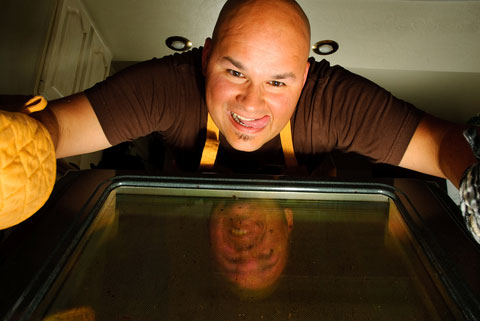
How did your last batch turn out? Would Martha give a cool nod of approval or would she wince in agony at the sorry sight?
We all know one of the biggest factors in successful baking is the ratio of ingredients. Having to measure our goods is what separates the men (bakers) from the boys (cooks). Though I always use a scale if weights are listed, I sometimes follow along to a recipe that is written in cups. Like a good lil’ baker, I’ll break out said measuring cups, and flex my OCD muscle, taking my time, spooning carefully, leveling off.
The other day I was messing around with a recipe for quadruple chocolate cake (hold on to your hats, kids, that post’s next). I whipped out an old notebook, sticky from years of splatters, and located a recipe that I meant to use as a starting point. Lo and behold, it was in cups. Since I was testing batters, I wanted the results to be as consistent as possible from batch to batch. An uneasy feeling crept up on me. Is it possible to get consistent results with a cup measure? An experiment was in order.
I spooned one cup of flour straight from the bag into the measuring cup…
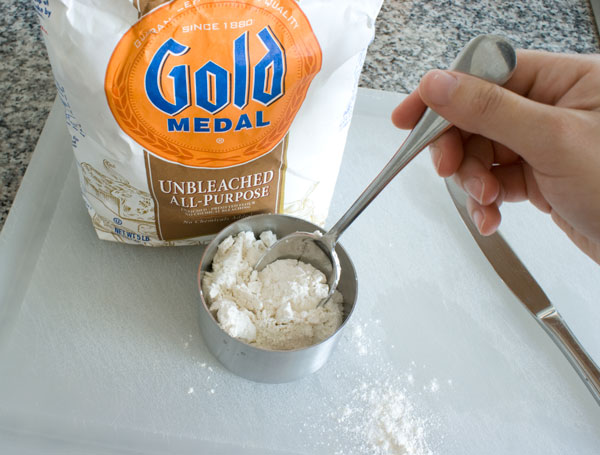
…until mounded…
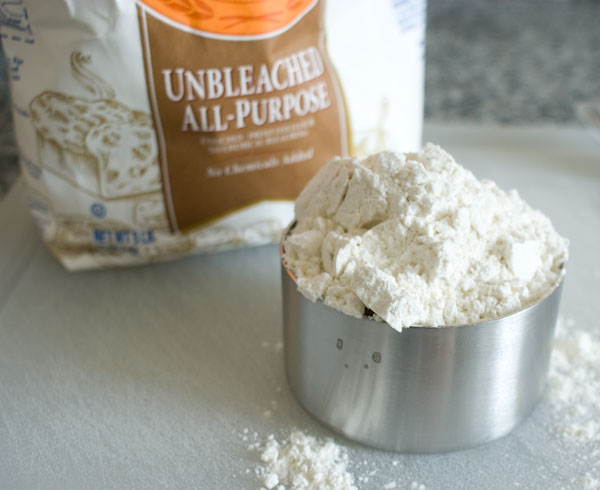
…scraped off the excess…
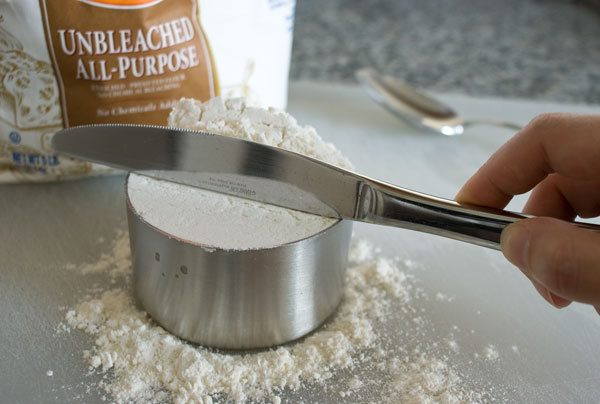
…then took note of the weight.
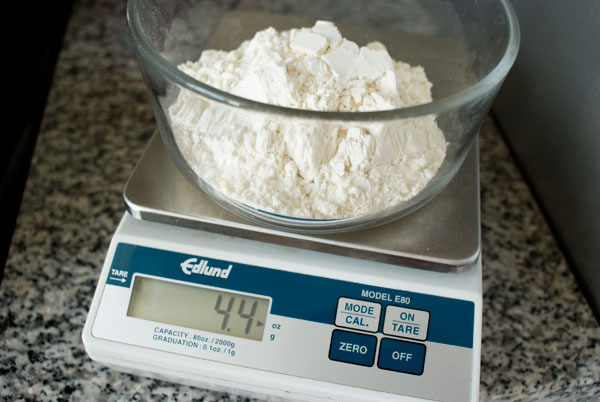
Then I did it again with a separate cup of flour.
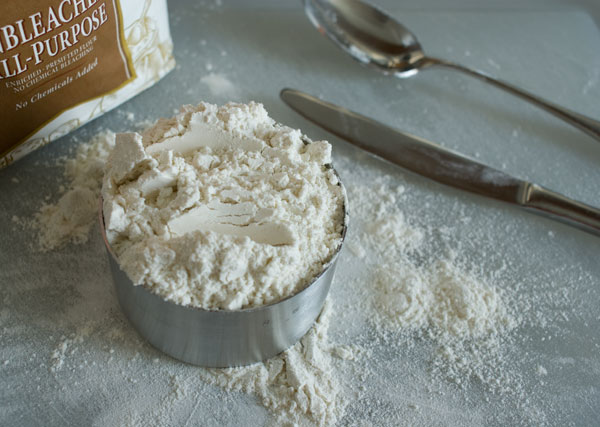
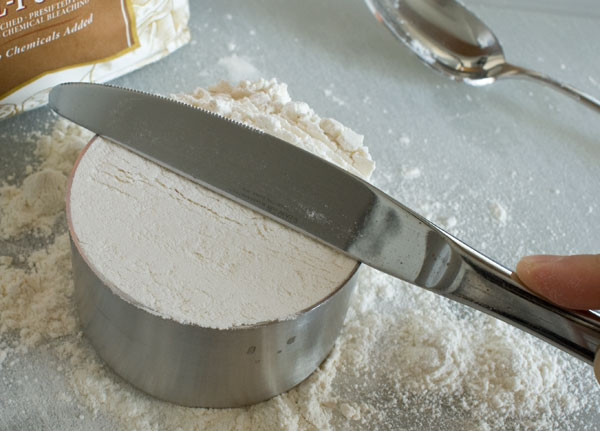
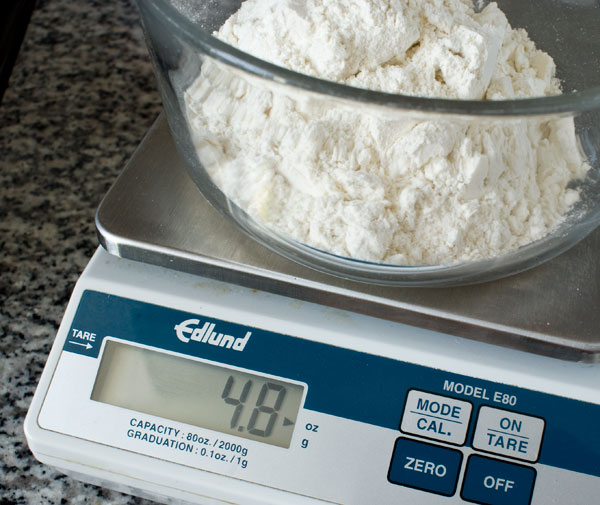
Turns out, there is a difference of .4 ounces in this case. Either I don’t know my own strength with a spoon or some cupfuls pack down more than others. Is .4 oz a lot? Well, if a recipe calls for 3 cups of flour, you could end up inadvertently omitting more than a full ounce.
Ok, ok, I don’t mean to create a panic a lá War of the Worlds. No need to spill out on to the sidewalks with rolling pins ablaze. A slight variance in measure is not necessarily going to make your three-layer hopeful collapse on your shoe, but the dessert probably won’t reach the full potential it’s capable of. It may be a little too dry or a little too dense, or a little soupier than last time. Us bakers are perfectionists. A little too something is just not good enough, unless it’s a little too good.
Obviously, the best thing is to weigh when possible. More and more enlightened cookbooks are including weight measures and our dinner rolls are the better for it. The scales I like best display both ounces and grams in small increments, are capable of weighing heavy quantities (up to 11 lbs.), and don’t automatically shut off before you get a chance to pour in your stuff.
Here’s one that people seem to like:
Oxo Good Grips Food Scale with Pull-Out Display
Mark my words. You’ll never look back.
10 Responses to “A Weighty Issue”
Post a Comment
Your E-Mail will be kept private. * = required fields.






I already asked for a food scale for Christmas – i can’t wait! 🙂
Great post. I often dread baking something from a recipe that measured in volumes not weight. I love my trusty little digital scales and measuring EVERYTHING – even water. I’m sure some great bakers don’t work so strictly, but that’s the appeal of baking to me.
Weights and measures are an oft overlooked topic.
Sometimes we assume what we’d be better off knowing beyond a doubt.
This post is a flake of reliable quality in a blizzard random outcomes.
I admire the PastryPal yet again.
You are so right about it! I have recently acquired a digital scale and convert (using online resources) everything from cups to grams before I even start baking.
I went to a King Arthur Baking demo, who said the spoon and sweep method is what they used. The Artisan Bread in Five authors use the “scoop and sweep” method. The scoop and sweep is heavier, but it depends on the recipe that you are using what you should do.
I do not have a scale, yet, but it is on the list! 🙂
Wow! Great entry! I have a scale but most recipes I encounter are in cups–never knew there could be so much variation. I might try converting my favorite recipes to weights by weighing them and noting the outcome (too dry, just right, and so forth). Thanks for sharing 🙂
I have been converting recipes into weights, just because there seems to be so much variation between volume measurements between here (Australia) and there (everywhere else recipes might be published). And given that I have two ‘tablespoons’, both of which say 15mL (isn’t it meant to be 20mL?) and they both look totally different…….. makes me wonder about the rest of the measuring implements in my kitchen.
Is it too OCD to weight teaspoons of baking powder?
Karen, It’s true, tablespoon measures are a little different. I wouldn’t necessarily say it’s OCD to weigh tablespoons, but there comes a point when 1 or 2 grams wont make enough of a difference to bother. Consider the fact that there’s always a touch of flour stuck to the bottom of a bowl, or some milk clinging to the sides of a glass or a little batter that still sticking to a mixing paddle. You can get a recipe as close as you can, but there will always be nuances of variation in ingredient weights. Still, it can’t hurt to weight them, right? I usually do :).
The one thing that has stopped me making American recipes has been the lack of specific measurements. I’ve tweeted about this to fellow UK professional bakers, who agreed it made life too difficult, and it is so time consuming to convert cups and sticks into grams or ounces. It is also nigh on impossible to find a definitive conversion chart – I gave up after printing off 6 different charts, giving different variants of cups to gram measurements. Oh, and don’t get me started on All Purpose Flour, which there is no equivalent alternative to in the UK, and we can’t even get it imported due to the treatment process in the US being illegal here!
Wow, Sarah. The flour treatment being illegal there is a scary thought. The process used in the US must be worse for your health than I thought!
It’s a shame you have to forego certain recipes due to lack of measurements. If you have the patience, you can try making them a few times, and tinkering until it’s to your liking. But of course, that can be a pain in its own right :).